1038 S. Hill St. Los Angeles, CA 90015 | map |
More Mayan Theatre pages: vintage exterior views | recent exterior views | ticket lobby | main lobby | mezzanine lobby | vintage auditorium views | recent auditorium views | booth and attic | stage | basement |
The news: It''ll reopen in January 2026 with new operators Mike Joher and his brother Chade, proprietors of the Heat Ultra Lounge in Anaheim. Thanks to Mike Hume for spotting the news. See a short video clip he spotted on Instagram. Also a story on CoStar News. The theatre had closed September 13, 2025 after 35 years as a club operation under the direction of Sammy Chao.
Opened: August 15, 1927 as a legit theatre focused on musical comedies. The opening attraction was the Gershwin musical "Oh, Kay!" with Elsie
Janis. The house was managed by Gerhold Davis and Edward Belasco, the same team that ran the Belasco Theatre next door. Fred J. Butler also had an interest in the operation. The Mayan has been a concert venue and nightclub since 1990. Photo: Bill Counter - 2018
Phone: 213-746-4674 New website: www.themayanla.com | Mike Joher on Facebook
Old Social media pages: Facebook | Instagram
They refer to the theatre next door as the E.L. Doheny Theatre, its name until very close to the opening on November 1, 1926 as the Belasco Theatre. Thanks to Mike Hume for locating the article.
An early drawing of the exterior. "Stowell Theatre" is written on the back of the image. The photo of the drawing was taken by The Mott Studios, who would later shoot the finished building. At the time they were located at 329 S. Hill. Thanks to Ken McIntyre for locating this for a post for the Photos of Los Angeles private Facebook group.
Part of the north end of the facade, a detail taken from a sheet in the Morgan, Walls & Clements Archive at the Huntington Library. It's from their drawing #9299. Also see drawing #9300, titled "Suggested design for stone jointing." Details around the windows and poster cases are on drawing #9307, drawing #9309 and drawing #9938. See a plan of the west end of the south exit passage. It's from drawing #9311. The doorway at the north exit passage is on drawing #9322.
Except for two sheets not with the main group, the Mayan plans on the Huntington site start with drawing #9275 and run through drawing #9329. Thanks to Mike Hume for locating these in the collection. Visit the Index to the MW&C Drawings that he has compiled for his Historic Theatre Photography site. There's also a 22 page index by Mike Callahan on Internet Archive. The architectural set is a delight to page through but lacking a few sheets here and there. There also are no electrical or mechanical drawings.
A detail from a 1950 Sanborn insurance map showing the Mayan and Belasco. Hill St. is on the left and 11th at the bottom. Thanks to Jeff Bridges for sharing this on Flickr. The Mayan occupies a lot with 100' of frontage on Hill St. and 150' in depth.
Seating: 1,491 originally with 713 on the main floor and 778 in the balcony. L.A. theatre historian Ed Kelsey comments that the seats were all red velvet. The main floor has been terraced and no longer has fixed seating. The original risers remain in the balcony but the seats have been removed. Want to sit? They'll give you a cushion.
"INDIAN ARCHITECTURE - Into the structure, the architects have incorporated the most modern design and equipment architecturally. The exterior is in ornamental stone designed by a young Mexican artist, Francisco Cornejo, who in his interior design and color, has embodied the findings of his extensive research into earliest known American and Mexican art, with a predominance of blue, brown, red and gold tones. Doorways, proscenium arches and the ceilings are of ornamental stone in Mayan design. The selection of the Mayan motif by Gerhold O. Davis was the result of important archeological discoveries in Central America a year ago.
"Entrance to the theater is through a large outer lobby, 18 x 32 feet, into the downstairs foyer. This and the mezzanine foyer, running the full width of the building, are decorated and furnished for the comfort of patrons during intermission, and smoking will be permitted in them as a result of the recent removal by the City Council of the ban on smoking in such places. Retiring rooms open off the mezzanine lounge. Auditorium illumination is by an indirect system. The large figure of the Mayan sun rays, from whose circumference the entire ceiling is lighted in white and amber tones, is in turn lighted by green and blue lights from a pendant fixture.
"FIRST CONNECTING STAGE - Of exceptional interest because it is the first time in America such practice has been followed, is the use of a twelve-foot connecting stage, on each side of the main stage, which is thirty-eight feet deep and has a width of forty-two feet. Space for fifty musicians is provided in the orchestra pit, which is 10 x 38 feet. From this two stairways lead below stage, to the musicians' room, which is 35 x 11 feet. An interesting innovation in stage lighting is the use of a balcony fifteen feet above stage level for the switchboard panel.
"With the exception of the de luxe star quarters just above the stage level, equipped with a suite of three rooms, and a star room on the stage level, all dressing-rooms open off the green room below, which is 45 x 25 feet. These include two star dressing-rooms, three dressing-rooms accommodating three persons each, five chorus rooms-two accommodating twenty-three each, two accommodating eight and one for six persons. On this level are also the wardrobe room and ventilating system. All downstairs rooms are well ventilated. Shower rooms for the convenience of the players are also in the basement. Ground was broken for the Mayan Theater last August, and the general contract awarded to the Scofield Engineering Company."
A drawing of the theatre that appeared in the August 14, 1927 issue of the Times. It was accompanied by "Gershwin Musical Show To Open New Mayan Theater," a lengthy article about the new playhouse by Edwin Schallert, the paper's theatre critic. The Mayan team, who also ran the Belasco next door, made the point of noting their belief that a cluster of theatres is helpful to all of them, especially when they have a diversity of attractions. Mike Hume has a PDF of the full story.
An August 15, 1927 opening day ad. Thanks to Mike Rivest for posting it on the Cinema Treasures page about the Mayan.
The talkies come to the Mayan:
"Journey's End" was a film that played the Mayan in 1930. Thanks to Ken McIntyre for finding the ad for a post for the Photos of Los Angeles private Facebook group.
An ad for the architects appearing in the 1931 L.A. Times Annual Midwinter rotogravure issue. Thanks to Hunter Kerhart for spotting it on the site Ad Sausage where it appears with many other ads from that edition.
Thanks to Ken McIntyre for finding this ad for a post for the Photos of Los Angeles Facebook group. Of course in some of the ads it was "Sid Grauman's Once in a Lifetime."
A ticket for "Once in a Lifetime." Thanks to Kurt Wahlner for finding it. Kurt researches all things Sid Grauman but especially items about the more famous Grauman enterprise, the Chinese. Visit his exhaustively researched site GraumansChinese.org.
The rear of the ticket with a warning from Sid to get there on time. Later the production traveled north to the Curran Theatre in San Francisco, opening there April 20, 1931. Homer Curran, the San Francisco theatre owner and producer, also sent some of his shows south to the Mayan in the early 30s, according to Ed Kelsey.
On April 9 Sid opened a production of Elmer Rice's "Street Scene" at the Mayan that ran until mid-May. Next was "Mrs. Bumpstead-Leigh," a comedy starring Mrs. Minnie Maddern Fiske. "The Man in Possession" starring Douglas Fairbanks, Jr. opened June 19 and closed July 21, 1931.
The WPA Federal Theatre project at the Mayan: From 1936 until 1939 the Mayan was used for WPA Federal Theatre Project productions such as "The Weavers, " "Follow the Parade," "Volpone" and many more.
A 1937 poster in the Library of Congress collection for "Green Grow the Lilacs" at the Mayan. Other items in the LOC collection include: "Allison's House" - 1938 | "Noah" - undated | "Censored" - 1936 | "The Amazing Dr. Clitterhouse" - 1938 | "Alien Corn" - 1938 | "The Sun Rises in the West" - undated. Also see a list of Mayan Theatre items in the collection and the Library's "New Deal Stage" index page.
For more Federal Theatre Project materials see the Federal Theatre Project Materials Collection items at George Mason University, where you can search their collection by theatre name or name of the production. Their collection includes: "Follow the Parade" - 1936 | "Blind Alley" - 1937 | "The World We Live In" - 1937 | free shows flyer - 1937 | another free shows flyer - 1937 | "It Can't Happen Here" - 1937 | "The Weavers" - 1937 | "The Sun Rises in the West" - 1938 | "Alison's House" - 1938 | "Judgment Day" - 1938 | "Run, Little Chillun" - 1938 |
Also see Robert Holcomb's article "The Federal Theatre in Los Angeles" on pages 131 to 147 in the June 1962 issue of the California Historical Society Quarterly. It can be accessed via the site JStor. The Los Angeles Public Library collection has a look at the stage taken by Herman Schultheis during a scene from "Run, Little Chillun" in 1938. That production closed in June 1939.
A pass to get into the "lusty" 1939 Los Angeles Civic Theatre production of "Desire Under The Elms." It's from the collection of Walnut Park based historian Wally Shidler. Thanks to Wally and also to Michelle Gerdes for photographing the item and sending it our way.
The Mayan in the 40s: Duke Ellington's "Jump for Joy" with Dorothy Dandridge and Ivie Anderson was one of the more interesting shows to play the theatre. It ran for 101 performances beginning July 10, 1941 to integrated audiences and caused quite a stir at a time when many downtown venues were still segregated.
An illustration of the fun ahead in "Jump For Joy." See the "Jump For Joy" page for some additional pages from the program. Thanks to Ken McIntyre for posting the program on Photos of Los Angeles. The production is discussed at length on page 33 of R.J. Smith's "The Great Black Way: L.A. in the 40s," Public Affairs, 2006.
A scene from Duke Ellington's production "Jump For Joy" at the Mayan in 1941. It's a Los Angeles Public Library photo.
A publicity shot of Duke Ellington at the Mayan. It's a Los Angeles Public Library photo. Also see a photo of Louise Franklin & Duke Ellington from "Jump For Joy."
Bill Robinson and a cast of 50 were in the revue "Born Happy" that opened at the Mayan June 21, 1943. Thanks to Ken McIntyre for finding the the ad for the Photos of Los Angeles Facebook page. The show had played the Alcazar in San Francisco in April and then did two weeks at the Biltmore beginning May 27 with Sid Grauman as the producer. For the Mayan run Sid wasn't involved. Later it got cut down to an hour to run between films at the Orpheum. Kurt Wahlner found a review of the Orpheum version in the August 28, 1943 issue of Billboard. It's on Google Books.
An ad in a 1944 issue of Playgoer magazine for Dorothy Dandridge in "Sweet 'n Hot," an "All Star Colored Musical Revue." The ad is from the Collection of Eric Lynxwiler on Flickr. See his great Paper Ephemera album for many more treasures. Thanks, Eric!
Martha Raye appearing in "Fun Time." It's a March 1945 ad located by Ken McIntyre for a Photos of Los Angeles post.
A 1946 film booking. Thanks to Ken McIntyre for finding the ad for a post on the Photos of Los Angeles Facebook page.
Ed Kelsey notes that post-war, the theatre tried a bit of everything to see what would bring in an audience. There were occasional forays into foreign film, adult "artie" films and burlesque revues. Film titles in late 1947 included "Daughter of Ra – Life Among the Nudists (Adults Only)" and "The Strange Story of Man’s Way with Woman (Swedish Film)." Thanks to Ken McIntyre for this 1948 ad.
A 1948 Times ad for "She Lost It in Campeche" and "Confessions of a Newlywed."
Another fine program in 1948. Again thanks to Ken McIntyre for finding the ad.
Frank Fouce takes over: The Mayan then went to Spanish language films (and occasional stage shows) with the acquisition of the building in late 1948 by Frank Fouce. He also also exhibited Spanish language product at the California, the Mason and the Million Dollar. In Spanish-language media the theatre was advertised as the Maya.
Senoritas onstage at the Mayan in a Frank Fouce produced show in 1949. It's a Los Angeles Public Library photo.
Porno time at the Mayan: In 1968 the Fouce family leased the building to Carlos Tobalina. It then became billed as the "Fabulous Mayan," a porno operation. He painted the facade colorfully that same year.
Tobalina triplexed the Mayan in 1969, work that fortunately has been undone. Thanks to Mike Rivest for this March 14, 1969 ad.
How can you resist? A short wait in line plus three color adult cartoons! It's a September 1969 ad from Roger Delfont's articles on the site Ad Sausage that analyze the film ads that appeared in the Los Angeles Free Press.
Tobalina bought the building from the Fouce family in 1969. Thanks to Ken McIntyre for finding this November 9 article in the L.A. Times, which nicely omits the detail that all those foreign films being shown were porno.
Ed Kelsey tells stories of the L.A. Conservancy booking one of their "Last Remaining Seats" screenings at the Mayan in 1988. Members were on their hands and knees cleaning the theatre beforehand -- while the theatre was open and running porno.
The Mayan becomes a music venue:
This was the invitation to an October 14, 1988 preview of the new club, initially to be called Lost City. The inside of the invitation promised that it was to be "Los Angeles's most exciting new Night Club Project." At the time of the preview, the theatre was still operating as a film house. Thanks to Daniel B. Sullivan, one of the partners with Sammy Chao in the nightclub conversion, for sharing the item from his collection. He added it as a comment to a post on the Los Angeles Theatres Facebook page and noted that he experienced first-hand the dismal condition of the theatre during its years as a porno operation.
It closed as a film house on June 11, 1989 with "Passion" as the last film screened. The Tobalina family leased the building to Chao and Sullivan to turn the theatre into the dance and music club that's now called the Club Mayan.
"After two incredible decades at HEAT Ultra Lounge in Anaheim, we’re proud to announce the next chapter in our journey — bringing our 20 years of nightlife innovation, community, and hospitality to Downtown LA’s iconic Mayan Theatre. When we opened HEAT back in 2008, Anaheim gave us the opportunity to grow from a local nightlife concept into one of Southern California’s longest-running and most respected venues. We’re deeply grateful for the city’s support over the years, and we’ve always believed in creating spaces that elevate the local entertainment scene.
"That said — opportunity comes to those who are ready to evolve. And when Anaheim couldn’t accommodate our next expansion, we decided to take our vision, our team, and our business expertise to Los Angeles — where the historic Mayan will soon shine again as a world-class entertainment destination. We’ll never forget where we came from. But we’re beyond excited about where we’re headed. HEAT built the legacy. The Mayan will define the future. Thanks To John Anthony, The Million Dollar Man, With The Million Dollar Plan."
The Mayan in the Movies:
Harvey Keitel makes a phone call from the lobby of the Mayan in Martin Scorsese's "Mean Streets" (Warner Bros.,
1973). The film, set in New York's Little Italy, also stars Robert De
Niro, David Proval, Amy Robinson, Cesare Danova and Richard Romanus. See the Historic L.A. Theatres in Movies post for another shot from the scene.
In "Save The Tiger" (Paramount, 1973) Jack Lemmon and Jack Gilford are business owners in trouble having a meeting in the balcony of the Mayan with their friendly neighborhood arsonist. See the Historic L.A. Theatres In Movies post for nine more shots of the sequence at the Mayan plus a drive by the El Capitan.
Heading to a premiere at the Mayan in Michael Winner's "Won Ton Ton, The Dog Who Saved Hollywood" (Paramount, 1976). See the Historic L.A. Theatres In Movies post for a view of the Mayan auditorium during the show as well as a shot of the Chinese Theatre forecourt from the beginning of the film.
We get a look at the Mayan's marquee as the guys drive away after a bombing at the Belasco in the blaxploitation spoof "I'm Gonna Git You Sucka" (United Artists, 1988). The film features Keenan Ivory Wayans, Bernie Casey, Isaac Hayes, Jim Brown, John Vernon, Antonio Fargas, Dawnn Lewis, Ja'net Dubois and Damon Wayans. Keenan Ivory Wayans directed. The cinematography was by Tom Richmond. See the Historic L.A. Theatres in Movies post for five shots of the bombing action at the Belasco.
Kurt Russell showing off the closed theatre that he plans to reopen as a nightclub in "Unlawful Entry" (20th Century Fox, 1992). Thanks to Marko Tudich for noting the use of the Mayan. Madeline Stowe plays Kurt's wife and Ray Liotta is a cop who develops an unwholesome attraction to her. Jonathan Kaplan directed. The cinematography was by Jamie Anderson. See the Historic L.A. Theatres in Movies post for thirteen more shots from the scenes at the Mayan.
Kevin Costner is in the Mayan lobby worrying about his client Whitney Huston who is there for an evening of clubbing in Mick Jackson's "The Bodyguard" (Warner Bros., 1992). See the Historic L.A. Theatres In Movies post for more Mayan views as well as shots of the Pantages and Shrine Auditorium from the film.
We get a nice walkabout on the main floor of the Mayan during the opening credits of Antoine Fuqua's "The Replacement Killers" (Columbia, 1998). It ends with some mayhem featuring Chow Yun-Fat. The film also gives us Tower and Million Dollar exterior shots as well as a long visit inside the Orpheum. See the Historic L.A. Theatres In Movies post for another Mayan shot as well as views of the other theatres seen in the film.
We spend a bit of time at the Mayan with Angelina Jolie and Ryan Phillippe in Willard Carroll's "Playing by Heart" (Miramax, 1998). See the Historic L.A. Theatres in Movies post for three more shots from the Mayan sequence as well as views of the Geffen Theatre in Westwood and the Sunset 5.
The Mayan is used for interior shots of the Roxbury, a legendary night club Chris Kattan and Will Farrell visit in "A Night at the Roxbury" (Paramount, 1998). See the Historic L.A. Theatres in Movies post for four additional shots from the scenes at the Mayan.
IMDb has a page on films shot at the Mayan.
The Mayan in videos and on TV: The theatre, inside and out, is featured in the Pointer Sisters 1983 video "Neutron Dance." It's on YouTube. Thanks to Marc Edward Hueck for spotting the theatre.
The Mayan was used for Stevie Ray Vaughn and Double Trouble's 1986 "Superstition" music video. It's on YouTube. The video includes shots of a black cat playing around with the counterweight system.
Roy H. Wagner notes that he shot scenes for the Robert DeLaurentis/Dick Wolf 1992 TV series "Mann and Machine" at the Mayan. It's a drama about a cop whose partner is a robot.
More Information: Visit Mike Hume's great page about the Mayan on his Historic Theatre Photography site. The Cinema Treasures page on the Mayan has lots more historical information about the theatre and many photos, mostly exterior views. Cinema Tour has some photos of the Mayan (mostly exteriors) on their page.
Charles Beardsley's "Hollywood's Master Showman - The Legendary Sid Grauman" (Cornwall Books, 1983) discusses Sid's legit presentations at the Mayan. See the Mayan Theatre album of Jeff Bridges on Flickr for 40 views of the theatre taken in 2008.
The Mayan is included in "Great American Movie Theaters, A National Trust Guide" by David Naylor (Preservation Press, Washington, D.C., 1987). The coverage includes a vintage ceiling view from the Theatre Historical Society/Terry Helgesen Collection.
See "Mayan Theatre in the 80's," an 8 1/2 minute video on YouTube from the Los Angeles Historic Theatre Foundation. Eric Lynxwiler has a lovely 123 photo 2008 "Lucha Va Voom!" album on Flickr. There are also many views of the Mayan in Eric's 500+ photo album of Los Angeles Theatres.
The Mayan gets covered in "Movie Palaces, Survivors of an Elegant Era" by Ave Pildas and Lucinda Smith (Clarkston N. Potter, New York, 1980; Hennessey + Ingalls, Santa Monica, 2000). Included is a c.1980 photo from up in the balcony.
The Mayan Theatre pages: back to top - history | vintage exterior views | recent exterior views | ticket lobby | main lobby | mezzanine lobby | vintage auditorium views | recent auditorium views | booth and attic | stage | basement |
| Downtown: theatre district overview | Hill St. and farther west | Broadway theatres | Spring St. theatres | Main St. and farther east | downtown theatres by address | downtown theatres alphabetical list |
| Westside | Hollywood | Westwood and Brentwood | Along the Coast | [more] Los Angeles movie palaces | the main alphabetical list | theatre history resources | film and theatre tech resources | theatres in movies | LA Theatres on facebook | contact info | welcome and site navigation guide |





























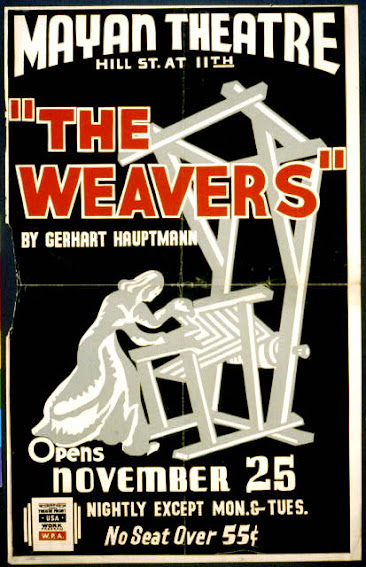













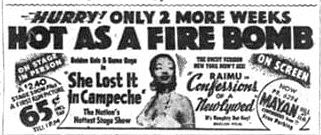










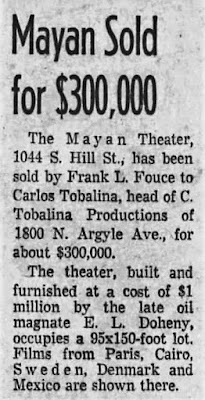





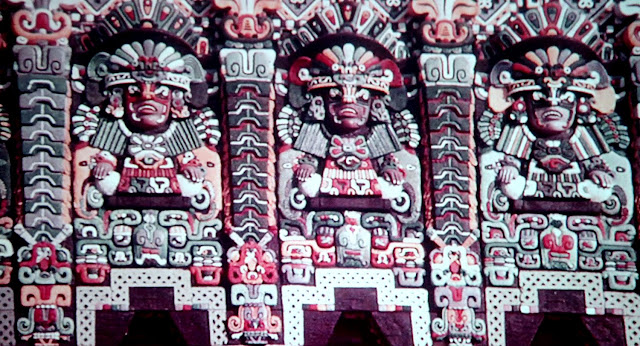













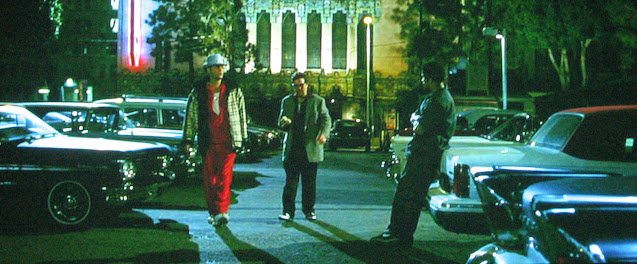

If you’re looking for a great exterior shot of the Mayan, Flesh and Bullets’ entire ending scene is outside the theater. Oddly, it’s a film by Carlos Tobalina by one of his rare non-pornos.
ReplyDeleteWell, that's fun. Thanks for the tip. I'll check it out!
DeleteWe also used the Mayan for Stevie Ray Vaughn's "Superstition" Music Video back in 86. Clip can be seen here: https://www.youtube.com/watch?v=JL9eO4-aDMs
ReplyDeleteThanks! Good to know.
Delete